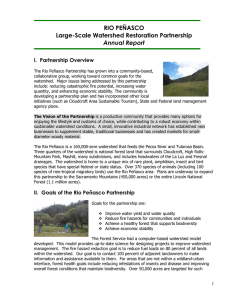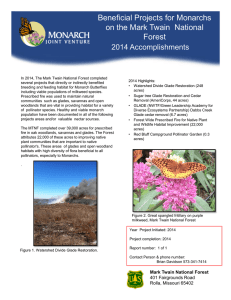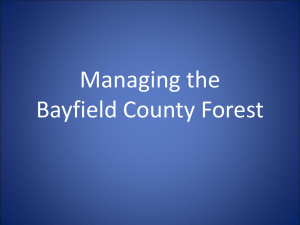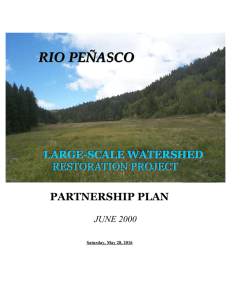RIO PEÑASCO Large-scale Watershed Restoration Partnership Annual Report I.
advertisement
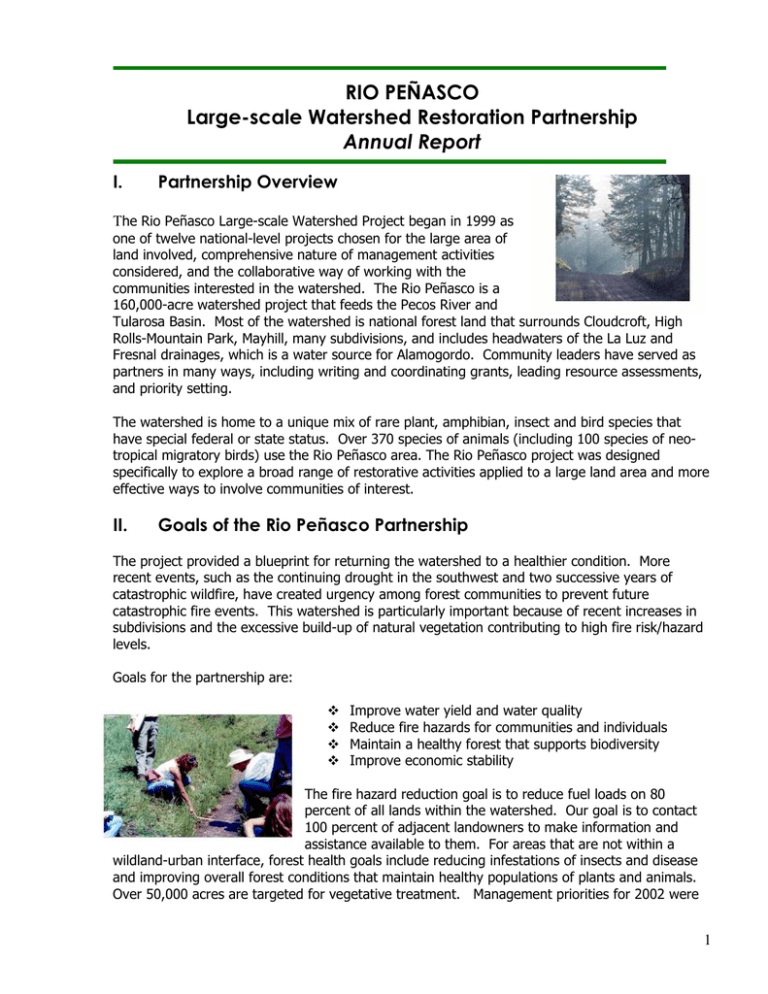
RIO PEÑASCO Large-scale Watershed Restoration Partnership Annual Report I. Partnership Overview The Rio Peñasco Large-scale Watershed Project began in 1999 as one of twelve national-level projects chosen for the large area of land involved, comprehensive nature of management activities considered, and the collaborative way of working with the communities interested in the watershed. The Rio Peñasco is a 160,000-acre watershed project that feeds the Pecos River and Tularosa Basin. Most of the watershed is national forest land that surrounds Cloudcroft, High Rolls-Mountain Park, Mayhill, many subdivisions, and includes headwaters of the La Luz and Fresnal drainages, which is a water source for Alamogordo. Community leaders have served as partners in many ways, including writing and coordinating grants, leading resource assessments, and priority setting. The watershed is home to a unique mix of rare plant, amphibian, insect and bird species that have special federal or state status. Over 370 species of animals (including 100 species of neotropical migratory birds) use the Rio Peñasco area. The Rio Peñasco project was designed specifically to explore a broad range of restorative activities applied to a large land area and more effective ways to involve communities of interest. II. Goals of the Rio Peñasco Partnership The project provided a blueprint for returning the watershed to a healthier condition. More recent events, such as the continuing drought in the southwest and two successive years of catastrophic wildfire, have created urgency among forest communities to prevent future catastrophic fire events. This watershed is particularly important because of recent increases in subdivisions and the excessive build-up of natural vegetation contributing to high fire risk/hazard levels. Goals for the partnership are: Improve water yield and water quality Reduce fire hazards for communities and individuals Maintain a healthy forest that supports biodiversity Improve economic stability The fire hazard reduction goal is to reduce fuel loads on 80 percent of all lands within the watershed. Our goal is to contact 100 percent of adjacent landowners to make information and assistance available to them. For areas that are not within a wildland-urban interface, forest health goals include reducing infestations of insects and disease and improving overall forest conditions that maintain healthy populations of plants and animals. Over 50,000 acres are targeted for vegetative treatment. Management priorities for 2002 were 1 fuels reduction in the wildland-urban interface and completing additional environmental analyses for future projects. III. Accomplishments A. Actions 1999-2001 2002* Thinning Small diameter trees Sawlogs Firewood 3,130 acres 500 acres 1,000 cords 225 acres 1530 cords Prescribed Burning Piles Broadcast 650 acres 1,500 acres 560 acres Watershed Improvements Riparian Meadow Restoration 4 springs 1,200 acres 60 acres Access Management Culverts Ditches Road Construction Reconstruction Maintenance Closure Obliteration Trail Relocation/Design Wildlife Habitat Improvement 2003+ 30,000-35,000 acres 4,500 acres 2 2 40 miles 12 miles 10 miles 2,500 acres 100 acres 25,000 acres Inventories/Surveys Recreation Trestle Depot Thinning-Cloudcroft Campground (CG)/Site Upgrades 5 acres Silver Saddle CG Apache CG Fir CG Rails-to-Trails Pedestrian Bridge Deerhead CG Sleepy CG Black Bear CG Aspen CG Hang Glider Site Power line Relocation 1 mile Heritage Mexican Canyon Trestle Restoration * The Peñasco Wildfire burned some areas scheduled to be treated. 2 B. Environmental Consequences/Outcomes Biological/Physical – Fire hazard reduction was achieved on about six percent (6%) of the targeted acres within the project area. Activities focused on acres for which fuels reduction (thinning trees and controlled burning) was the highest priority. Completed watershed improvement projects include modernizing campground toilets, realigning over 10 miles of road, building six drainage structures to increase habitat for the endangered Sacramento thistle, and monitoring of Cloudcroft checkerspot butterfly habitat (1,200 acres). Thinning and controlled burning have the potential to create new butterfly habitat and protect habitat from catastrophic fire. Socio-economic – The Mescalero Apache Tribe purchased the White Sands Forest Products sawmill. This mill uses area lumber to produce construction-grade 2x4s. Through a Forest Service Economic Action Program grant awarded to Otero County, the existing sawmill has been retrofitted to update obsolete equipment and add the capability to produce 2x6, 4x4, and 6x6 inch lumber and process smaller-diameter trees (down to 4 inch diameter material). These improvements resulted in 50 additional jobs. State and Federal Grants State Grants 2001-2002 Western State Foresters Wildland-Urban Interface Otero County $366,400 77 projects Lincoln County $477,700 185 projects Federal Grants 2001-2002 Lincoln National Forest Collaborative Forest Restoration Rural Community Assistance Economic Action Program Community Planning $893,500 $735,000 Area citizens and homeowners’ associations are $ 60,000 taking a lead role in reducing fire hazard on private property. The Lincoln National Forest provided data and support to a County-funded research project that identified historic conditions of the forest and established possible management goals to achieve those conditions. District and Forest personal made presentations to local home association groups to help raise awareness of how to reduce fire danger, collaboration efforts, and opportunities for financial assistance. C. Growth During 2002, the Rio Peñasco Partnership solidified into a group that has common goals and is working together to achieve those goals. Political leaders at the national, state, and local levels joined in supporting a collaborative effort. The collaborative effort was expanded to a much larger geographic area, and a pilot project was developed and proposed to legislative leaders. The National Forest County Partnership Restoration Program (CPR) is an innovative proposal to restore watersheds and larger landscapes to more desirable and sustainable conditions on three Pilot Forests; the Apache-Sitgreaves National Forests in Arizona, the Grand Mesa, Uncompahgre and Gunnison National Forests in Colorado, and the Lincoln National Forest in New Mexico. The CPR Program was developed in response to the growing interest of local governments to be more meaningfully involved in defining future landscape and watershed conditions and appropriate actions to achieve desired outcomes. This CPR Program addresses ecosystem decline, threats to homes and lives from wildfire, and other factors contributing to ecological, social, and economic impacts within the three Forests and surrounding areas. 3 The program promotes the co-lead partnership of the above three National Forests and seventeen counties in an effort to represent a diversity of landscapes, communities and issues and to allow for a more thorough evaluation of the approach. Pilot designation will provide the flexibility in funding and authorities needed to support collaborative processes, integrate best available science, and expedite implementation of projects to address the complexity of issues faced by Forests and communities. Local Government and Forest Service representatives will identify key community members to serve as an oversight group. This group will convene a series of workshops designed to finalize a strategic approach, using the best science available to improve ecosystem conditions. Benefits include meeting the demands and needs of the users and forest customers of the these Forests, adjacent state, county, and private lands. Private property owner associations continue to create and maintain a safer wildland-urban interface. A number of these associations, including Robin Hood Estates, Cloud Country Estates, and Mount Joy Estates, are utilizing formal partnerships with State and Federal agencies. D. Peñasco Wildfire Rehabilitation The Peñasco Wildfire began on April 30, 2002, and spread through Curtis, James, Cox, and Rio Peñasco Canyons. Approximately sixteen miles southeast of Cloudcroft, the fire burned more than 15,000 acres, of which over 5,000 acres were private land. Private landowners, Cloudcroft, Mayhill, Otero County, NRCS, local Peñasco Fire Burned Area Emergency Rehabilitation Partnership fire departments, New Mexico State Forestry, Soil and Water Conservation Districts, Youth Conservation Corps, New Mexico State Highway Department, and Lincoln National Forest quickly mobilized to assist a burned area emergency rehabilitation (BAER) team to complete fire rehabilitation projects in the watershed before monsoon flooding began. 4 Together, the community and BAER team re-seeded 8,500 acres of public and private land, aerially applied 3,000 bales of hay, and built 210 logsilt dams, 22 earthen tanks, 85 wooden trash racks, 165 earthen check dams. Other activities included contour felling of trees on 400 acres and removing 30,000 yards of silt from existing earthen tanks. These actions treated 16 miles of stream channel. This local crew builds trash racks in Upper Curtis Canyon from dead and burned trees along with other mostly natural materials. They became so skilled, they could put up a sturdy structure in 2-3 hours! IV. Challenges and Change This year, the National Fire Plan was integrated with management plans of local communities/governments. Several community-based fire and rural community planning groups convened; those in Ruidoso, Cloudcroft, and Timberon are most active. Interaction led to projects designed to meet specific community needs. The Natural Resources Conservation Service, Forest Service, State and County Governments also partnered to support hazard reduction projects on private land. Ruidoso – Continue to work with Urban Forester on cooperative ventures and planning. Entered into formal agreements to reduce hazardous fuels in and around the community. Cloudcroft – Finished the Trestle, Exchange, and Bailey thinning projects specifically designed as part of community interaction with project planning. Trained local VFD in wildland fire tactics. Jointly developed Staging Area and Communications Plans for Initial Attack in the interface. Worked on hazard 5 reduction with unincorporated subdivisions within Forest boundary; funded projects on private land using NRCS and Wyden Amendment. Timberon – Working with community, McGregor Bombing Range and BLM to develop fire plan for this remote community. BLM has lead on environmental analysis for projects south and west of community, which hopefully will cover both BLM and FS lands and reduce timeframes to end product. Queen - 6,000-acre (2,000 WUI, 4,000 NWUI) prescribed fire on area directly south of this community was highly supported by residents. They volunteered to do clearing around private land boundary. These projects along with current and past mechanical treatments complete Queen WUI projects, reducing condition class from 3 to 2. Future projects will continue to condition class 1. A number of interest groups have been convened, and a diversity of issues and viewpoints are represented. However, not all communities of interest are strongly represented. A challenge is for all groups is to develop a common vision that allows each to accomplish both individual and group goals. V. Future Actions and Opportunities With the initiation and implementation of the National Fire Plan, focus has turned towards wildland-urban interface work. Phase 3 and other future actions will focus on issues such as watershed health outside the wildland-urban interface, travel management, cooperative water management, and trail and dispersed recreation management. The Rio Peñasco Partnership will review the partnership plan, and a project implementation plan will be developed. Additional partners will include more homeowners associations and individuals who can take advantage of grants and other funding opportunities. VI. Partnership Budget/Costs Partnership contributions are displayed below. Contributor USFS Mescalero Otero Co. Cloudcroft State of NM Others NRCS Amount $853,000 $50,000 $108,000 $50,000 $90,000 $65,000 $400,000 $1,616,000 Percentage 53% 3% 7% 3% 6% 4% 25% 100% Partner Contributions 2002 USFS Mescalero 25% Otero Co. 4% 6% 3%7% 52% 3% Cloudcroft State of NM Others NRCS 6 VII. Partnership Contacts Key contacts of the Rio Peñasco Partnership include: Gary Wood, Chairperson – Village of Cloudcroft gary@mountainmonthly.com Mike Nivison – Otero County Commissioner Barbara Luna – New Mexico State Forestry Dept. Jose Martinez – Lincoln National Forest Supervisor Rick DeIaco - Urban Forester, City of Ruidoso Jeff Steinborn - Senator Bingaman jeff_steinborn@bingaman.senate.gov (505) 682-6029 (505) 682-2411 sleepy@trailnet.com (505) 354-2231 bluna@state.nm.us (505) 434-7200 jmmartinez@fs.fed.us (505) 258-4343 voruf@zianet.com (505) 523-6561 Other partners include: Mescalero Forest Products – Jim Bridge Robin Hood Estates – Bill Wright Cloud Country Estates – Steve Stone 7
